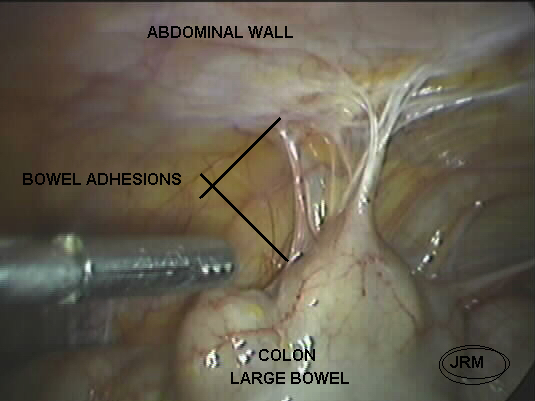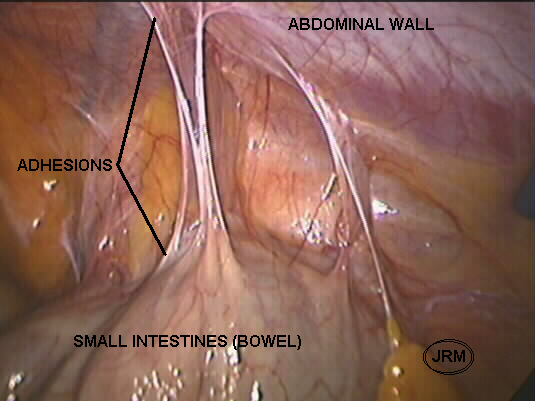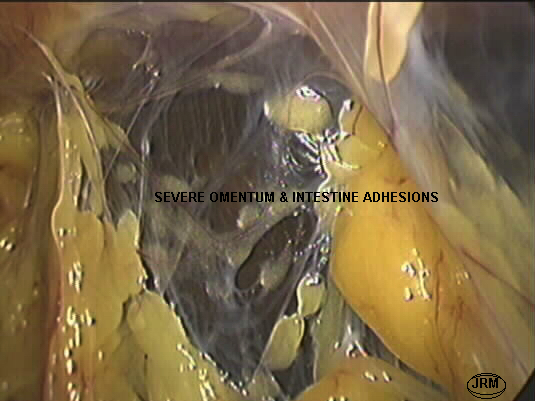ADHESIONS LAPAROSCOPIC ADHESIOLYSIS
The formation of adhesions after hysterectomy or any other pelvic or abdominal surgery can readily be treated with laparoscopic adhesiolysis, unfortunately, no surgeon can guarantee the permanency of surgery to remove adhesions. There is often the problem of adhesion reformation.
Drs. Miklos & Moore understands the pain and frustration that adhesions can cause. Many surgeons may tell you that adhesions do not cause pain, that’s because they have never suffered from what you are experiencing…. PAIN. If you’re seeking information on what causes abdominal or pelvic adhesions, read more below. You will learn about laparoscopic adhesiolysis – the minimally invasive surgery used to remove adhesions.
With 45 years of combined surgical experience and more than 10,000 surgical patients, Drs. Miklos & Moore understand the severity of pain that patients suffer with abdominal and pelvic adhesions. Patients from all over the world and patients with as many as 20 previous abdominal or pelvic surgeries have been successfully treated with laparoscopic adhesiolysis at Miklos & Moore Urogynecology.
Drs. Miklos & Moore have a bowel, bladder and ureter injury rate of less than 1% and a less than 1 in 500 chance of their patient getting a large incision (i.e. laparotomy) to complete the adhesiolysis. It comes as no surprise that patients from around the world travel to have their surgery.
INTRODUCTION
Adhesions form when inflammation occurs on the inner surface of the abdominal and pelvic cavity. This inflammation creates scar tissue that is a normal part of healing. Adhesions become a problem when patients begin to experience symptoms and complications from their presence.
Abdominal adhesions attach to abdominal organs such as: the intestines, bowel, colon, liver, gallbladder, peritoneum (lining of the abdominal wall), appendix, spleen, kidneys or ureters. Pelvic adhesions can be found in the lowest portion of the abdomen and within the confines of the pelvic bones and pelvic organs such as: the uterus, vagina, fallopian tubes, ovaries, rectum, bladder, and sigmoid colon.
SYMPTOMS
Adhesions can be asymptomatic or patients can have mild or severe symptoms. Symptoms commonly experienced by patients with abdominal adhesions include: bloating, nausea, and abdominal pain. Pelvic adhesions are commonly associated with increased pain with menses, generalized pelvic pain, and infertility. One of the most serious complications of abdominal and pelvic adhesions is bowel obstruction. Typical symptoms of mild obstruction included abdominal cramps, abdominal pain, abdominal distension, which are made worse with eating. Patients with severe obstruction will often have severe abdominal pain, vomiting and severe distension of the abdomen. This is an emergent condition and usually the patient will automatically take herself to the emergency room.
TREATMENT
The medical term for adhesion removal surgery is adhesiolysis. Drs. Miklos & Moore are experts in adhesion removal surgery and perform only laparoscopic surgery for abdominal and pelvic adhesions. See their minimally invasive and meticulous technique by clicking the video below.
DR. MIKLOS & DR. MOORE ALWAYS ATTEMPT TO MINIMIZE TRAUMA AND BLEEDING TO THE PATIENT AT THE TIME OF ADHESION REMOVAL BY DOING THE FOLLOWING:
Using laparoscopic surgery methods for abdominal adhesions and pelvic adhesions – Drs. Miklos and Moore use scissors with minimal electric energy.
Minimizing electric energy – Many surgeons will burn every adhesion prior to cutting them, to prevent bleeding. However, burning adhesions creates thermal damage and the tissue begins to slough (i.e. ‘rot’) over the next few days. This creates sticky tissue, which in turn creates even more adhesions. Drs. Miklos & Moore use electric cautery (i.e. burning) energy only when needed. They estimate they use less than 10% on all adhesions. They cut adhesions first, and only if the bleeding persists will they use energy to cauterize or stop the bleeding.
Gently Handling Tissue – Minimizing trauma to the area by handling tissue with the utmost care is crucial to minimizing adhesion formation.
;Minimizing blood loss – Blood loss comes from traumatized tissue. If a surgeon minimizes trauma to the tissue, then there will be less blood loss. Less blood loss means less adhesion formation.
No powdered gloves – Some surgical gloves actually have a talc type powder on them. Drs. Miklos & Moore make sure their gloves are foreign body free. Foreign bodies mean more adhesions.
Anti-adhesive agents – Though no agent has ever been proven to definitively work against preventing adhesions, Drs. Miklos & Moore are not against using products such as: Interceed, Arista etc.
For more than 25 years Miklos & Moore Urogynecology have treated pelvic adhesion, adhesions after hysterectomy or bowel resections or multiple previous abdominal and pelvic surgery by performing laparoscopic adhesiolysis.



